
29 Nov, 2013
First UNWTO Conference in Ninh Binh Helps Spiritual Tourism Come of Age in Asia
Ninh Binh, Vietnam — The Asia-Pacific travel & tourism industry entered a new phase of its history with Nov 21-22 convening of the first conference on spiritual tourism in Asia. Set against the backdrop of the spectacular bronze Buddha images in the Bai Dinh pagoda in Ninh Binh, about 90 kilometres south of the Vietnamese capital of Hanoi, two clear factors were apparent: 1) Barely a word was mentioned about marketing, branding, image-building or social media; 2) Discussions were dominated by the challenge of how to manage the growing numbers of both worshippers and sightseers.
|
EDITOR’S COMMENT This dispatch is free of copyright restrictions. The text and pictures may be used free of charge, but MUST contained the credit-line: Reprinted courtesy of Imtiaz Muqbil, Executive Editor, Travel Impact Newswire, www.travel-impact-newswire.com |
The absence of marketing gobbledygook was not surprising. Spiritual tourism is the only niche-sector of the travel & tourism industry which commands a captive audience, has a high repeat-traffic ratio, and perhaps most important actually grows in times of crisis. Across the Asia-Pacific, the Middle East and other parts of the world, thousands of churches, mosques, temples, mausoleums, sacred lands, tombs, burial grounds, pagodas, stupas and many more such ancient and modern sites are attracting passionate believers and followers. Among the most prominent examples of such movements are the Islamic Haj to Mecca and Madinah, the Buddhist circuit to Bodhgaya and Lumpini, and Hindu pilgrimages to the many religious spots along the River Ganges, and elsewhere in India.
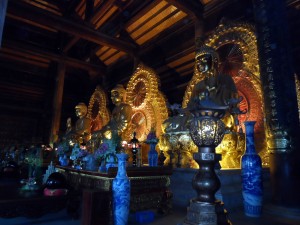 Three spectacular Buddha images at the Bai Dinh Pagoda |
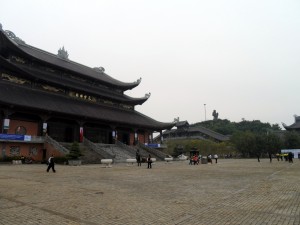 The courtyard cum parking area of the Bai Dinh pagoda, with another Buddha image on the hilltop in the distance. |
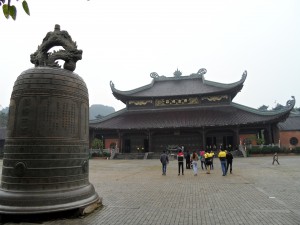 Another view of the massive structure housing the Bai Dinh pagoda Buddha images |
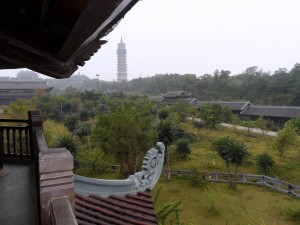 The view from the bell-tower |
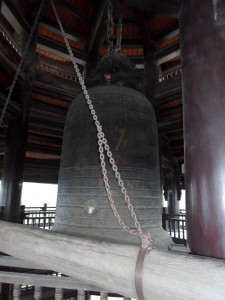 The “great bell” said to be weighing 60 tons |
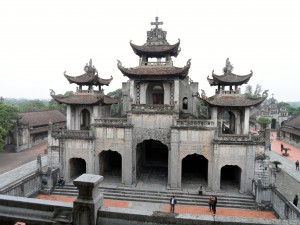 The Phat Diem Stone Cathedral, 28 kms east of Ninh Binh city. |
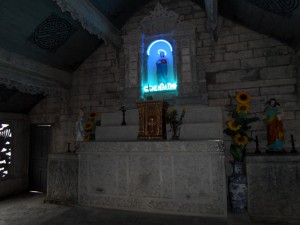 The altar inside the Phat Diem Stone Cathedral. |
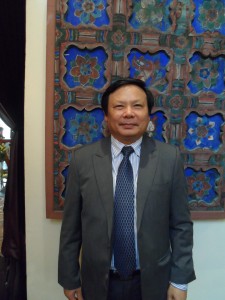 Mr. Nguyen Van Tuan, Chairman of Viet Nam National Administration of Tourism |
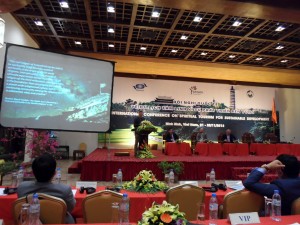 The conference in session |
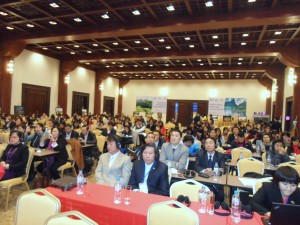 The huge turnout at the conference. |
The International Conference on Spiritual Tourism for Sustainable Development came at the initiative of UNWTO Secretary-General Dr Taleb Rifai who visited Bai Dinh Pagoda in May 2012. He proposed it as a good venue for the inaugural Asian sequel to the first Conference on Tourism, Religions and Dialogue of Cultures organised by the UNWTO in Cordoba in October 2007. The Vietnamese picked up on this idea as part of the activities for Visit Vietnam Year – the Red River 2013. It also fitted with Viet Nam’s preparation for the nearby ecotourism site, the Trang An Landscapes Complex, to be submitted to UNESCO for recognition as a world natural and heritage site.
The conference was attended by Viet Nam’s Vice President, Mrs Nguyen Thi Doan, Minister of Culture, Sports and Tourism Mr. Hoang Tuan Anh and more than 350 delegates, mostly Vietnamese provincial tourism authorities, NGOs, private sector executives, diplomats and academics. According to the concept paper, it was designed to promote: a) understanding and safeguarding of spiritual, religious and cultural values and assets in the context of tourism, b) development, management, promotion, and interpretation of spiritual tourism products, and, c) socioeconomic inclusion and empowerment of local communities, in particular of vulnerable groups.
Vietnam’s Spiritual Tourism Policy Agenda
The event fitted in with Vietnam’s tourism plan to balance the national visitor mix. Tourism is now one of Viet Nam’s top five foreign exchange earning sectors. In 2012, the country counted more than 6.8 million international visitors, up 13.8%, and 32.5 million domestic tourists, generating more than 1.5 million jobs. In Jan-Oct 2013, visitors touched 6.2 million, up 10.4% over Jan-Oct 2012. Tourism authorities are optimistic that the target of 7 – 7.5 million international visitors by 2015 in fact will be reached this year.
In his presentation, Mr. Nguyen Van Tuan, Chairman of Viet Nam National Administration of Tourism, said that spiritual tourism has become a popular trend generally worldwide and particularly in Viet Nam, with domestic tourists leading the way. In addition to visiting pagodas, temples, mausoleums, shrines, churches and memorials, Vietnamese spiritual tourists indulge in sightseeing, cultural trips and engaging with local lifestyles. “By these activities, people can feel and experience the values and spiritual freedom, balance and contribute to quality of life.” He added, “Tourists are given pure and noble experience through spiritual tourism as they can feel the living balance and the happiness in soul as written in Buddhist philosophy.”
Mr. Tuan added, “In Viet Nam, Buddhism has the biggest following (up to 90%), that co-exists with other religions such as: Catholic, Cao Dai, Hoa Hao … Spiritual tourism is closely linked with worshipping, showing gratitude to national heroes, ancestors, forefathers, relatives, parents and village deities. It is considered a return to the source of national origin, as expressed in the Vietnamese proverb, ‘When drinking water, remember the source’. It is also linked to rebalancing activities such as Zen, meditation and yoga. Spiritual tourism activities have become more and more active, deep as well as an essential/indispensable need in the life of the majority of people.”
Mr. Tuan said that of the 32.5 million domestic tourists in 2012, about 13.5 million (41.5%) visited only spiritual sites. Some of the most popular were Temple of Ba Chua Xu (lit. Lady of the Realm) in An Giang Province (3.6 million), Huong Pagoda (1.5 million); Bai Dinh Pagoda (2.1 million), Yen Tu Pagoda in Quang Ninh province (2.3 million), Ba Den Mountain Tourism Complex in Tay Ninh province (2.2 million); Con Son Kiep Bac Historical Site in Hai Duong province (1.2 million). Other popular spiritual tourism complexes include: Hung Temple (Phu Tho province), Huong Pagoda (Ha Noi city) and Phat Diem (Ninh Binh). Another typical and distinctive spiritual tourist site, Truc Lam Yen Tu, exists only in Viet Nam.
Of the 6.8 million international visitors to Viet Nam in 2012, only 12% visited spiritual sites. (See statistical charts on visitation to Vietnamese spiritual sites at the bottom of this dispatch).
Mr. Tuan said spiritual tourism has created thousands of local jobs in boat-rowing, cycle-rides, souvenir sales, catering and guiding. “As told by a ferry rider in Ninh Binh, Bai Dinh ten years ago was an unknown destination. It was not easy to access, the harvest was difficult with uncertain income, and there was a lot of unemployment. Since the Pagoda built, their life has changed a lot. They are not only farmers but also service providers. Now, after one boating season they can earn as much as three crops can do.”
The Bali Experience
The conference also learned about experience of Bali, known as the “Island of God” and “Island of a Thousand Temples”. In his keynote, Mr. I Gede Ardika, former Minister of Tourism and Culture of Indonesia and Member of the UNWTO Committee on Tourism Ethics, positioned spiritual tourism within the context of what he called the biggest and serious challenges of this 21st century, viz., global warming and climate change. He said, “Uncontrolled economic growth development has a tendency to ruin our environment and our planet. The unlimited growth concept causes over-exploitation of natural resources as well as human and financial resources. The objective of economic growth is to improve people’s prosperity. But the prosperity concept adopted is mainly on physical or material aspect or money.”
“Many communities or countries have different moral philosophy on what is poor or rich. A “poor” person is somebody who doesn’t know what “enough” is, even though he or she has a lot of money. He or she has a tendency to be greedy. A “rich” person knows what enough is, and knows how to differentiate desire and need. Based on this philosophy, tourism development has to have a ‘carrying capacity’ concept that puts ‘a limit’ on development, taking into account the scarcity of space, natural resources (water, air, forest, flora and fauna).”
Mr. Gede Ardika said Balinese culture is a unique blend of pre-historic, traditional and modern civilizations and Hinduism. The ultimate goal of Balinese life is spiritual harmony, peacefulness and physical prosperity. Among those local wisdoms is Tri Hita Korona, the three elements of happiness, a concept of harmony and balance of life. The flip side, disharmony, will lead to disorder, destruction and alienation from social life and nature.
Mr. Gede Ardika admitted that Bali has arrived exactly at such a crossroad. “Nowadays Bali is facing considerable challenges of modernization that also affect life styles by introducing new paradigms as well as new values. This modern life style is measured by material or physical value. It is guided by money, material or physical achievements whereas spiritual values such as honesty, good conduct of life and morals have almost vanished.
“This pressure has caused conflicting situations between the ‘traditional way of life’ and the ‘modern way of life’. Ecological transformations have been caused by uncontrolled land-use practices. Economic transformation has been caused by the shift from agricultural to industrial economy. Demographic transformation has been caused by the high and heterogeneous density of the population. Transformation in information has been caused by new technologies in information that enable the Balinese to have contacts on a local, national and international level. All those transformations have put pressure on the socio-cultural life of the Balinese and could also bring about an evolutionary process affecting Balinese culture,” Mr. Gede Ardika said.
“Disneylands” warning
Another powerful speech was delivered by Mr. Faruk Pekin, CEO of FEST Travel Agency, a pioneer of cultural and responsible tourism in Turkey. Describing spiritual tourism as a journey and an experience, he said it is going to be a tourist phenomenon of the 21st century. “Millions of foreigners or domestic travellers are looking for healing activities such as yoga, Ayurveda, and meditation classes, visiting sacred places, trying to enlighten and dignify soul, body and mind, looking for authentic multi-faith cultural activities, trying to rediscover the revitalizing powers of nature, and seeking cultural, environmental, and ecological consciousness.”
Showing several slides of his global travels, he agreed that spiritual tourism could be a conduit for promoting peace but was now in danger of being over-commercialised. At the same time, Mr Pekin rued the emerging results of this growth, saying that the throngs of worshippers and visitors, both domestic and foreign, has now become way too much, especially in many parts of Asia and across much of the world. Warning that spiritual spots were at risk of becoming “disneylands,” he said he has no solution to the problem because it faces the same dilemma as just about all other forms of tourism.
Mr. Pekin said that in some places in India, the domestic crowds are getting so large that the original holy spots can no longer handle them. As a result, replicas are being created to divert the visitors. “Numbers is good, but if the numbers increase too much, then what’s going to be done?” He cited the famous Topkapi palace in Istanbul which is not very big and can only take a limited number of people. In recent years, however, it has experienced an eightfold growth in visitation. “What they are going to do?” he said.
He cited the example of Bhutan as a good example of a potential solution – visitor numbers are kept under check with a minimum levy of US$200, which helps keep visitors under control but generates a guaranteed income. He also noted other problems related to over-crowding, such as the stampedes which occur when crowd control measures break down. “Spiritual tours are supposed to be conducted in a calm, peaceful and serene way. That’s what make them special but that’s often now what happens,” he said. “Big numbers are good for politicians but not good for the people.”
A summary of some of the other speeches:
(+) Mr. Kai Partale, Tourism Sector Specialist in the EU-funded Environmentally and Socially Responsible Tourism Capacity Development Programme in Vietnam, He said that globalization and pressurized lifestyles in a fast-changing world lead people to seek to escape and to take a break from a stressful and materialistic life to try to find a work/leisure balance. Spiritual tourism, closely linked to religious and cultural tourism, and with an emphasis on self-awareness, wellness and revitalization, has become a means to harmonize body, mind and heart, and can be experienced in many places in Vietnam.
(+) Ben Bowler, founder and director of World Weavers, a social enterprise specializing in authentic spiritual adventures: In 2008, Mr. Bowler founded Monk for a Month in northern Thailand, a deep immersion and spiritual-development program to experience Thai Buddhism. It quickly became a hit on social media, leading to the launch of another 26-day programme in the Indian Himalayas (Spiti Valley).
In 2010 Mr. Bowler created a stir when launching Muslim for a Month in Turkey which was soon followed by the Sufi Mystic Experience. Both programs offered immersion into Anatolian Islam and the mystical aspects of Sufism with a particular focus on the life and works of Jalaluddin Rumi. Mr. Bowler said it was an extraorindary programme intended to “break down stereotypes and prejudices against Muslims.” While it attracted a storm of media attention, he said, it was a struggle to market to a general audience due to the “challenging associations with the term ‘Islam’ while the less controversial terms ‘Sufi’ and “Sufism” have relatively low recognition levels in the market.” It produced very different results from the Buddhist programme and was discontinued. Said Mr. Bowler, “For a small, socially-driven organisation, we did not have the resources to go the distance.”
Now, he is seeking suitable partners for a new venture, the ‘Interfaith Express’, a spiritual tour across northern India.
(+) Mr. Amitava Bhattacharya, Founder and Director, banglanatak.com, India. A trained mechanical engineer who also studied at the London School of Economics, he now works on community-led cultural tourism. He said that much remains to be done for the tourism industry to be ‘value’ rather than ‘profit’ driven. “Tourism also often fails to address environmental considerations, and hence we are left helpless when disasters such as the Uttrakhand flooding (India) occur. Spiritual tourism destination planners and managers need to be very careful in addressing all of these points, especially the carrying capacity, the involvement of people and the environmental issues. Worldwide tourism talks of relating the sector’s objective to Millennium Development Goals (MDGs), however, the industry hasn’t yet done enough to meet such aims. Thus, even after such extensive growth, it fails to be recognized as a ‘critical industry’, capable of meeting development needs.
“After all, tourism may have the greatest potential to foster mutual respect between visitors, communities and countries, contributing to national development, international growth and peace. For spiritual tourism to succeed, more care needs to be taken to understand the content of tourism, to educate all stakeholders on the values of spiritual tourism and to work towards achieving sustainable development covering economic, environmental and social equity.”
(+) Jose Paz Gestoso, Managing Director of the Xacobeo Galicia, The Way of St. James, Spain: “It is no longer a strictly Catholic pilgrimage; Buddhists, Shintoists, Lutherans, Calvinists and other Christian churches travel to Santiago driven by a contemporary spiritual feeling, in search of an inner experience that is intense and exciting. In this sense, the universal values of the pilgrimage to Santiago should be highlighted: solidarity, friendship, hospitality, etc., They are values that unite people with other people, people with places and spaces, through links that are both intangible and ineffable and that are greatly valued by international contemporary culture.
“The steady contact with history and nature must also be taken into account, for The Way of St James crosses a geography that is sacred, with endless centuries of history and culture, and is also a sacred space in itself. It is a space that integrates pilgrims so that they can relive the same (or similar) experiences as those of millions of other pilgrims over the ages. It is not, ultimately, a distance journey; a pilgrimage that involves a defined number of kilometres. Instead, it is a pilgrimage that crosses a natural environment that is loaded with history, emotion and culture, one that leads pilgrims to an inner discovery, to a dialogue with themselves, with their fellow travelers and with the inhabitants of local communities, enabling them to interact with time, rather than with space.”
(+) Ms. Marina Diotallevi, Head of the Ethics and Social Dimensions of Tourism Programme at the World Tourism Organization (UNWTO) since 2003. According to her, the responsible and sustainable use of natural and cultural assets in the development of spiritual tourism can serve as a catalyst for cultural revitalization, reproduction and long-term development of the destinations. At the same time, a massive and uncontrolled influx of tourists can destabilize what are often fragile communities. Therefore, it is imperative that the tourism sector acts in close collaboration with tradition bearers to ensure that spiritual tourism is based on mutual respect, cultural sensitivity and the responsible behavior of all stakeholders, including visitors.
Conclusion
The conference ended with the Ninh Binh Declaration on Spiritual Tourism which included a call, initially issued by VNAT Chairman Tuan, to form a network of spiritual destinations amongst UNWTO member states. Such a network will allow spiritual sites to exchange experiences and seek sustainable and cost-effective solutions to what are largely common problems.
In his wrap-up remarks, Zoltan Somogyi, UNWTO’s Executive Director for Member Relations and Services, backed this idea. He said, “The pending challenge will be to identify adequate methodology and gather the support of governments, destinations, tourism businesses and religious leaders to facilitate networking and exchange the most pertinent good practises and case studies at the global level.” He concluded, “The UNWTO is convinced that this conference will be a turning point in tackling the subject of spiritual tourism.”
The next conference on a similar theme, the first International Congress on Pilgrimages and Tourism, is to be held in Santiago de Compostela, Spain, in September 2014.
| Table 1 Total of tourists to popular Vietnamese spiritual sites 2008-2012 |
||||||
| Site | 2008 | 2009 | 2010 | 2011 | 2012 | Avg growth rate (%) |
| Temple of Ba Chua Xu, An Giang | 2.62 | 3.02 | 3.48 | 3.67 | 3.68 | 10.5 |
| Bai Dinh Pagoda | 1.10 | 1.02 | 1.72 | 1.98 | 2.13 | 27.8 |
| Yen Tu Pagoda | 1.80 | 2.10 | 2.11 | 2.21 | 2.23 | 19.8 |
| Nui Ba Den Tourism Complex | 1.80 | 1.86 | 2.02 | 2.15 | 2.19 | 6.0 |
| Huong Pagoda | 1.26 | 1.36 | 1.40 | 1.48 | 1.47 | 6.4 |
| Con Son-Kiep Bac Historical Site | 0.82 | 1.06 | 1.08 | 1.09 | 1.14 | 17.1 |
| Tran Temple of Nam Dinh-Day Palace | 0.88 | 0.92 | 0.98 | 0.99 | 0.92 | 1.8 |
| My Son Sanctuary | 0.17 | 0.18 | 0.2 | 0.21 | 0.22 | 6.2 |
| Source:Reports from related Departments of Culture, Sports and Tourism |
||||||
| Table 2 Avg. Length of Stay at popular sites in 2012 |
|
| Site | Days |
| Temple of Ba Chua Xu, An Giang | 1.3 |
| Bai Dinh Pagoda | 1.0 |
| Yen Tu Pagoda | 0.84 |
| Con Son-Kiep Bac Historical Site | 0.5 |
| Ba Den Mountain | 0.34 |
| Mang Den | 1.8 |
| Huong Pagoda | n/a |
| Tran Temple of Nam Dinh-Day Palace | 0 |
| My Son Sanctuary | 0 |
| Source: Reports from related Departments of Culture, Sports and Tourism | |



Liked this article? Share it!